NVIDIA’s GeForce GTX Titan Review, Part 2: Titan's Performance Unveiled
by Ryan Smith & Rahul Garg on February 21, 2013 9:00 AM ESTPower, Temperature, & Noise
Last but certainly not least, we have our obligatory look at power, temperature, and noise. Next to price and performance of course, these are some of the most important aspects of a GPU, due in large part to the impact of noise. All things considered, a loud card is undesirable unless there’s a sufficiently good reason to ignore the noise.
It’s for that reason that GPU manufacturers also seek to keep power usage down, and under normal circumstances there’s a pretty clear relationship between power consumption, heat generated, and the amount of noise the fans will generate to remove that heat. At the same time however this is an area that NVIDIA is focusing on for Titan, as a premium product means they can use premium materials, going above and beyond what more traditional plastic cards can do for noise dampening.
| GeForce GTX Titan Voltages | ||||
| Titan Max Boost | Titan Base | Titan Idle | ||
| 1.1625v | 1.012v | 0.875v | ||
Stopping quickly to take a look at voltages, Titan’s peak stock voltage is at 1.162v, which correlates to its highest speed bin of 992MHz. As the clockspeeds go farther down these voltages drop, to a load low of 0.95v at 744MHz. This ends up being a bit less than the GTX 680 and most other desktop Kepler cards, which go up just a bit higher to 1.175v. Since NVIDIA is classifying 1.175v as an “overvoltage” on Titan, it looks like GK110 isn’t going to be quite as tolerant of voltages as GK104 was.
| GeForce GTX Titan Average Clockspeeds | |||
| Max Boost Clock | 992MHz | ||
| DiRT:S | 992MHz | ||
| Shogun 2 | 966MHz | ||
| Hitman | 992MHz | ||
| Sleeping Dogs | 966MHz | ||
| Crysis | 992MHz | ||
| Far Cry 3 | 979MHz | ||
| Battlefield 3 | 992MHz | ||
| Civilization V | 979MHz | ||
One thing we quickly notice about Titan is that thanks to GPU Boost 2 and the shift from what was primarily a power based boost system to a temperature based boost system is that Titan hits its maximum speed bin far more often and sustains it more often too, especially since there’s no longer a concept of a power target with Titan, and any power limits are based entirely by TDP. Half of our games have an average clockspeed of 992MHz, or in other words never triggered a power or thermal condition that would require Titan to scale back its clockspeed. For the rest of our tests the worst clockspeed was all of 2 bins (26MHz) lower at 966MHz, with this being a mix of hitting both thermal and power limits.
On a side note, it’s worth pointing out that these are well in excess of NVIDIA’s official boost clock for Titan. With Titan boost bins being based almost entirely on temperature, the average boost speed for Titan is going to be more dependent on environment (intake) temperatures than GTX 680 was, so our numbers are almost certainly a bit higher than what one would see in a hotter environment.
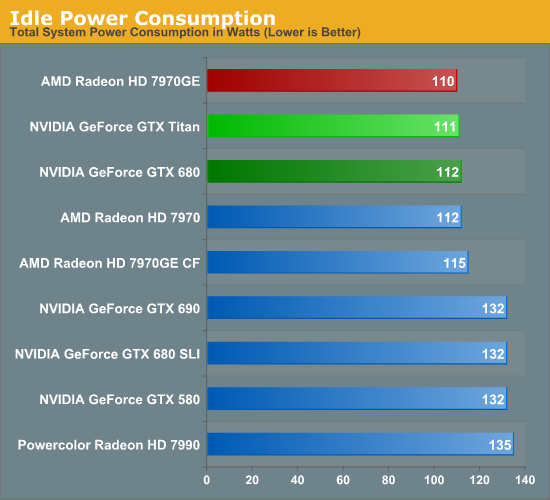
Starting as always with a look at power, there’s nothing particularly out of the ordinary here. AMD and NVIDIA have become very good at managing idle power through power gating and other techniques, and as a result idle power has come down by leaps and bounds over the years. At this point we still typically see some correlation between die size and idle power, but that’s a few watts at best. So at 111W at the wall, Titan is up there with the best cards.
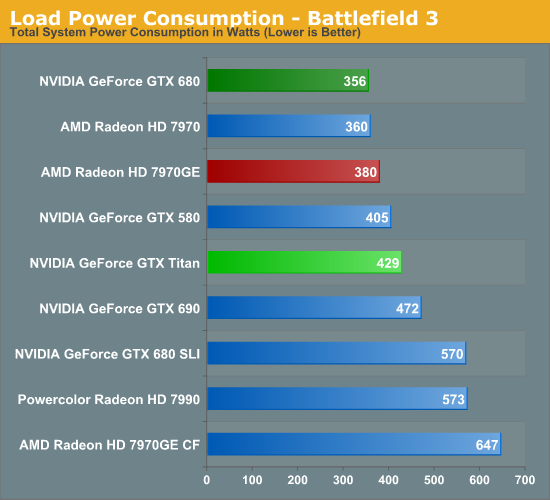
Moving on to our first load power measurement, as we’ve dropped Metro 2033 from our benchmark suite we’ve replaced it with Battlefield 3 as our game of choice for measuring peak gaming power consumption. BF3 is a difficult game to run, but overall it presents a rather typical power profile which of all the games in our benchmark suite makes it one of the best representatives.
In any case, as we can see Titan’s power consumption comes in below all of our multi-GPU configurations, but higher than any other single-GPU card. Titan’s 250W TDP is 55W higher than GTX 680’s 195W TDP, and with a 73W difference at the wall this isn’t too far off. A bit more surprising is that it’s drawing nearly 50W more than our 7970GE at the wall, given the fact that we know the 7970GE usually gets close to its TDP of 250W. At the same time since this is a live game benchmark, there are more factors than just the GPU in play. Generally speaking, the higher a card’s performance here, the harder the rest of the system will have to work to keep said card fed, which further increases power consumption at the wall.
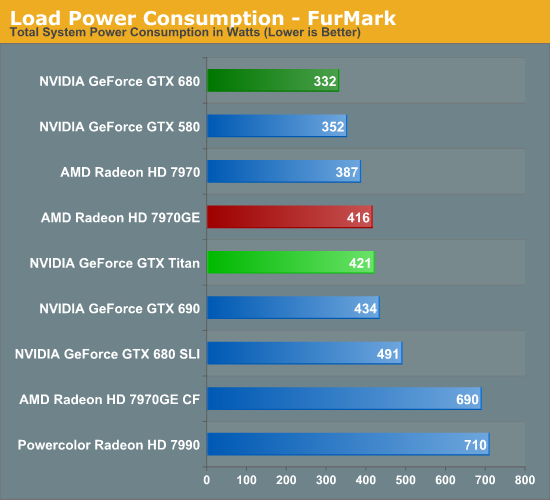
Moving to Furmark our results keep the same order, but the gap between the GTX 680 and Titan widens, while the gap between Titan and the 7970GE narrows. Titan and the 7970GE shouldn’t be too far apart from each other in most situations due to their similar TDPs (even if NVIDIA and AMD TDPs aren’t calculated in quite the same way), so in a pure GPU power consumption scenario this is what we would expect to see.
Titan for its part is the traditional big NVIDIA GPU, and while NVIDIA does what they can to keep it in check, at the end of the day it’s still going to be among the more power hungry cards in our collection. Power consumption itself isn’t generally a problem with these high end cards so long as a system has the means to cool it and doesn’t generate much noise in doing so.
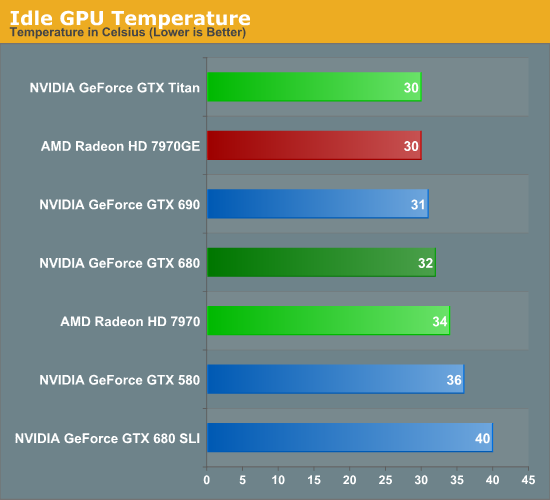
Moving on to temperatures, for a single card idle temperatures should be under 40C for anything with at least a decent cooler. Titan for its part is among the coolest at 30C; its large heatsink combined with its relatively low idle power consumption makes it easy to cool here.
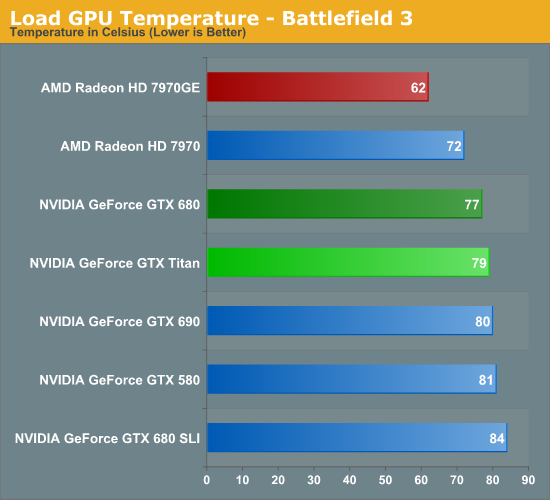
Because Titan’s boost mechanisms are now temperature based, Titan’s temperatures are going to naturally gravitate towards its default temperature target of 80C as the card raises and lowers clockspeeds to maximize performance while keeping temperatures at or under that level. As a result just about any heavy load is going to see Titan within a couple of degrees of 80C, which makes for some very predictable results.
Looking at our other cards, while the various NVIDIA cards are still close in performance the 7970GE ends up being quite a bit cooler due to its open air cooler. This is typical of what we see with good open air coolers, though with NVIDIA’s temperature based boost system I’m left wondering if perhaps those days are numbered. So long as 80C is a safe temperature, there’s little reason not to gravitate towards it with a system like NVIDIA’s, regardless of the cooler used.
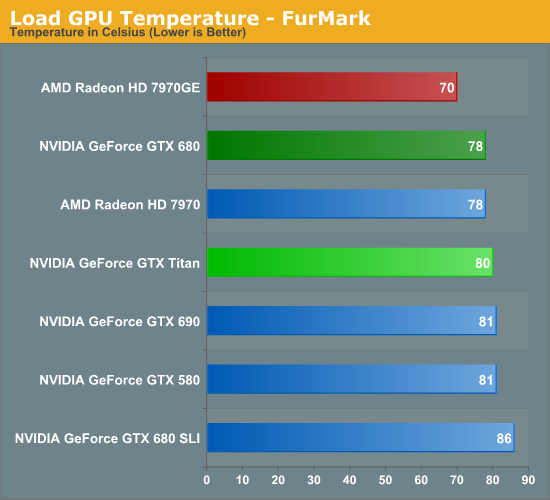
With Furmark we see everything pull closer together as Titan holds fast at 80C while most of the other cards, especially the Radeons, rise in temperature. At this point Titan is clearly cooler than a GTX 680 SLI, 2C warmer than a single GTX 680, and still a good 10C warmer than our 7970GE.

Just as with the GTX 690, one of the things NVIDIA focused on was construction choices and materials to reduce noise generated. So long as you can keep noise down, then for the most part power consumption and temperatures don’t matter.
Simply looking at idle shows that NVIDIA is capable of delivering on their claims. 37.8dB is the quietest actively cooled high-end card we’ve measured yet, besting even the luxury GTX 690, and the also well-constructed GTX 680. Though really with the loudest setup being all of 40.5dB, none of these setups is anywhere near loud at idle.
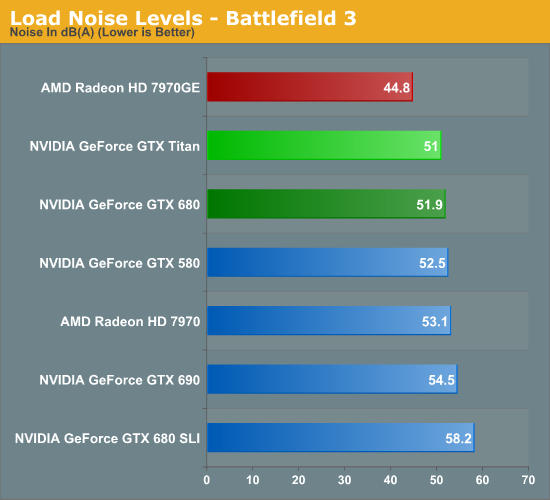
It’s with load noise that we finally see the full payoff of Titan’s build quality. At 51dB it’s only marginally quieter than the GTX 680, but as we recall from our earlier power data, Titan is drawing nearly 70W more than GTX 680 at the wall. In other words, despite the fact that Titan is drawing significantly more power than GTX 680, it’s still as quiet as or quieter than the aforementioned card. This coupled with Titan’s already high performance is Titan’s true power in NVIDIA’s eyes; it’s not just fast, but despite its speed and despite its TDP it’s as quiet as any other blower based card out there, allowing them to get away with things such as Tiki and tri-SLI systems with reasonable noise levels.
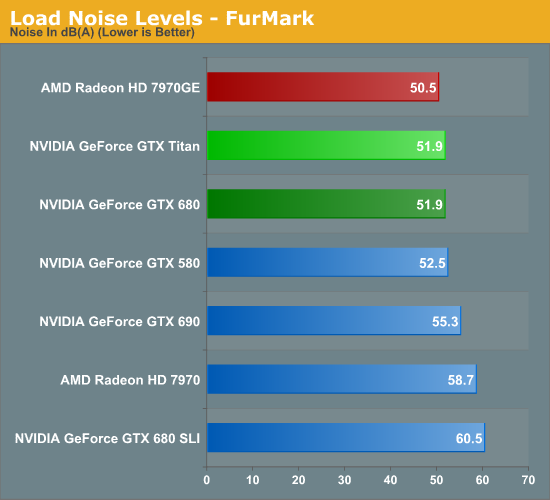
Much like what we saw with temperatures under Furmark, noise under Furmark has our single-GPU cards bunching up. Titan goes up just enough to tie GTX 680 in our pathological scenario, meanwhile our multi-GPU cards start shooting up well past Titan, while the 7970GE jumps up to just shy of Titan. This is a worst case scenario, but it’s a good example of how GPU Boost 2.0’s temperature functionality means that Titan quite literally keeps its cool and thereby keeps its noise in check.
Of course we would be remiss to point out that in all these scenarios the open air cooled 7970GE is still quieter, and in our gaming scenario by actually by quite a bit. Not that Titan is loud, but it doesn’t compare to the 7970GE. Ultimately we get to the age old debate between blowers and open air coolers; open air coolers are generally quieter, but blowers allow for more flexibility with products, and are more lenient with cases with poor airflow.
Ultimately Titan is a blower so that NVIDIA can do concept PCs like Tiki, which is something an open air cooler would never be suitable for. For DIY builders the benefits may not be as pronounced, but this is also why NVIDIA is focusing so heavily on boutique systems where the space difference really matters. Whereas realistically speaking, AMD’s best blower-capable card is the vanilla 7970, a less power hungry but also much less powerful card.










337 Comments
View All Comments
Tetracycloide - Thursday, February 21, 2013 - link
That's the thing, it's not a 'consumer gaming card.' It's a consumer compute card. Obviously the price for performance for gaming makes no sense but that's not their target market.ronin22 - Thursday, February 21, 2013 - link
This exactly!It's an amazing card for computing.
I wish I could get one...
Blazorthon - Thursday, February 21, 2013 - link
In reply to both of your comments, I have to ask this: If that is justification for its price, then why is it that AMD doesn't have their Tahiti cards priced like that and why didn't Nvidia price their previous consumer compute cards like that (GTX 280, GTX 285, GTX 480, GTX 580, etc.)?CommandoCATS - Friday, February 22, 2013 - link
Because this seems like a specialized thing for people who care about compute tasks within NVidia's CUDA universe (and things like iRay, which didn't exist when previous generations first came out).The truth is that in academia and research, CUDA is still the top dog (just do a google scholar search). I'm sure for most gamers, the GTX 680 is the way better deal. However, this is essentially a Tesla K20 for 1/3rd of the cost, so it's kind of a bargain from that perspective.
cheersloss - Saturday, February 23, 2013 - link
Exactly right. There is nothing about this card that is a value. The same compute functions were there in the older flagships as well, the gtx 580, 480, 280 etc.Titan is just an overpriced, overhyped trainwreck. Another attempt at a cashgrab on the gullible.
CeriseCogburn - Saturday, February 23, 2013 - link
The gullible that have the several thousands of extra they can spend that you don't have and cannot spend.Certainly poorboy feels better after having called his superiors gullible. The jelly is seeping through at an extraordinary rate.
cheersloss - Saturday, February 23, 2013 - link
Exactly right. There is nothing about this card that is a value. The same compute functions were there in the older flagships as well, the gtx 580, 480, 280 etc.Titan is just an overpriced, overhyped trainwreck. Another attempt at a cashgrab on the gullible.
CeriseCogburn - Saturday, February 23, 2013 - link
LOLGood you run the 280, and I'll run the Titan, and we can be equal and best friends, and I'll tell you over and over all the benchmarks and games and fps scores and compute tests are lying and your 280 is just as good and the same and you're right and I wish so badly that I was as poor as you and just bought a used 3 gen back nVidia card, but they fooled me, the gullible gamer.
CeriseCogburn - Tuesday, February 26, 2013 - link
ROFL - aww poor baby, now tessellation and compute is a total loss for amd, too as you conveniently forgot to include the 680, 670 660Ti 660 650Ti 650. hahahahha u people suck.So I can buy 2 amd cards that crash and don't run CF at all 33% of the time, or I can buy the most awesome top card in the entire world of gaming and play all the titles and be just great, or I can buy 2 nVidia cards and SLI them and have every game run except correctly except 1 while amd CF fails often...
I can buy the most stable, fully featured, many more featured nVidia card, or I can buy the dying no catalyst driver writers worth their salt (fired for savings) or left for better waters or headhunted, crashing piece of rotten unsupported glitching amd crap.
$999 looks like a bargain basement price to me. I can hardly wait to own The Shield, too.
Innovation. Awesomeness. New features. Unified drivers THAT JUST WORK.
Features ported BACKWARDS to prior generations.
Cuda
PhysX
Frame Rate Target
Boost
Stable dual card setups
Same game day drivers
Honest company not cheating liars like amd
I BUILT THIS co-founder Jen-Hsun Huang current CEO, a perfect example of the awesomeness of capitalism and personal success and the American Dream in REAL LIFE. lol
( Oh I bet those little OWS activist amd fanboys we have here are shooting blood through every pore)
Why in the world would I buy an amd card ? There's only one reason - to try to save a dying loser in a kind act of CHARITY - and frankly, what we have for amd fanboys is nothing short of the most evil little penny pinching crying whining baby SCROOGES I have ever seen.
So we can FORGET IT when it comes to the amd fanboy rabble here supporting AMD - they support only their own selfish fanboy agenda and psychotic public pocketbook panhandling.
I'd like to thank TheJian for pointing out amd fail coverage, vs the ignoring of the nVidia FINANCIAL SUCCESS STORY:
amd Q earnings coverage
"
http://www.anandtech.com/show/5465/amd-q411-fy-201...
http://www.anandtech.com/show/5764/amd-q112-earnin...
http://www.anandtech.com/show/6383/amd-q3-2012-ear...
http://www.anandtech.com/show/6690/amd-q412-and-fy...
"
nVidia Q earnings coverage
http://www.anandtech.com/show/6746/tegra-4-shipmen...
LOL - let it burn you crybabies to the CORE, I hope blood shoots from your eyes...
xaml - Sunday, March 3, 2013 - link
Don't leave out the biggest "crybaby" of all, yourself.